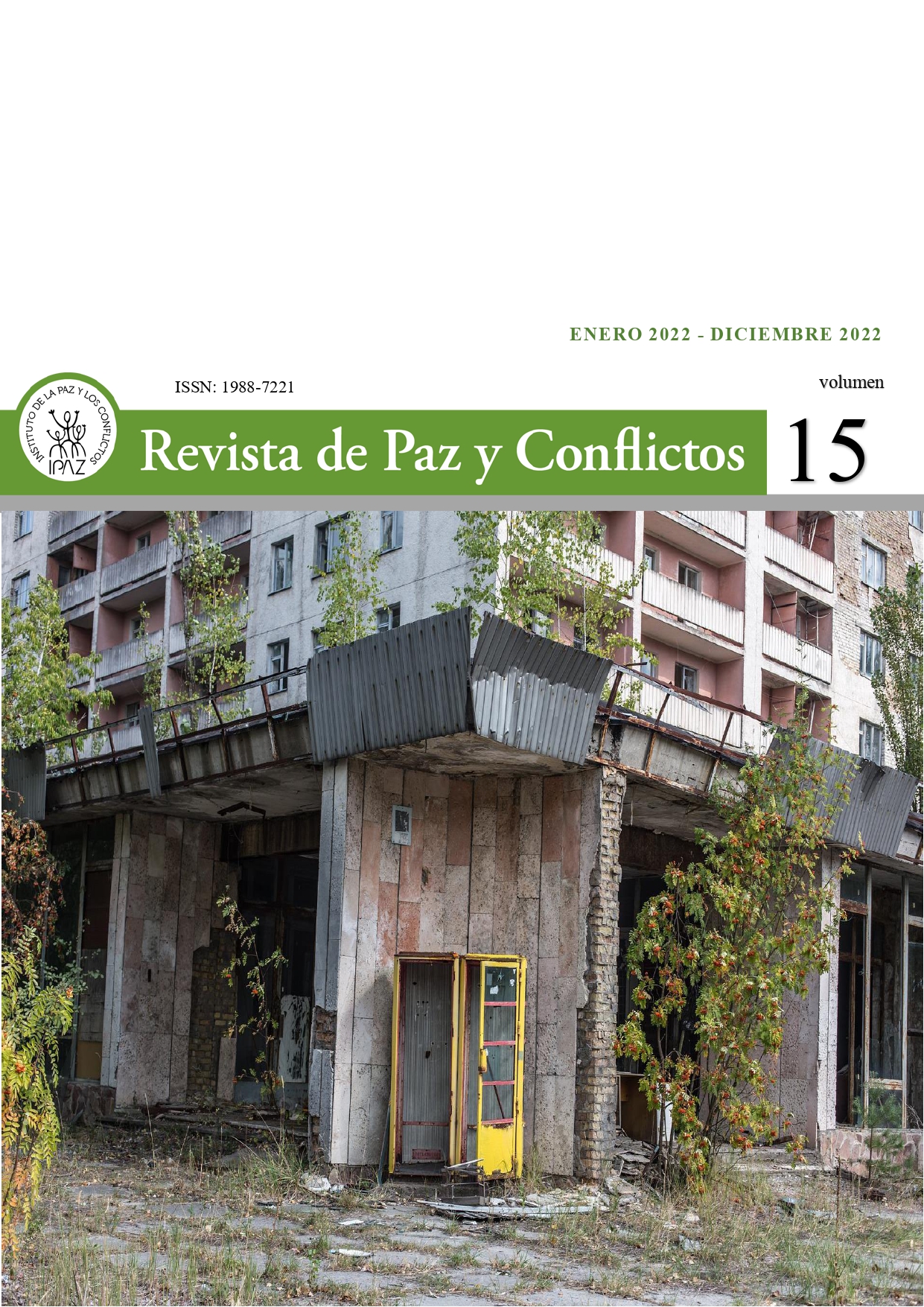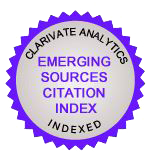Silent rifles? Criminal agendas and paramilitary demobilization in Colombia under the Peace Triangle
DOI:
https://doi.org/10.30827/revpaz.15.18138Palavras-chave:
Criminal Agendas, Peace Processes, Peace Triangle, Violent Non-State Actors, United Self-Defense Forces of ColombiaResumo
How do criminal agendas affect a peace process with violent non-state actors? This article attempts to resolve this question by presenting a qualitative analysis of the demobilization process of the United Self-Defense Forces of Colombia (AUC) during the government of Alvaro Uribe using the Peace Triangle as an analytical framework, based on three study variables: issues, behavior and attitudes.The review from this model aims to make a double contribution to peace studies. On the one hand, it fills a gap in academic knowledge about the sustainability of peace processes. And, on the other, to examine the relationship between criminal agendas and conflict resolution. The research reveals that the former Colombian President's inadequate management of criminal agendas transformed the peace negotiation into a damage control strategy since it did not intend to modify the scale of predatory crimes committed by the AUC, but rather to shape its behavior
Downloads
Referências
Alsema, Adriaan (2014). Paramilitary Killing Spree was Colombia ‘state policy:’ Judge. Colombia Reports. [online] https://colombiareports.com/paramilitary-killings-colombia-state-policy-judge/ [accessed: May 2nd 2020].
Alsema, Adriaan (2012). Parapolitics Scandal. Colombia Reports Fact Sheet. [online]http://colombiareports.co/parapolitics/ [accessed: June 13th 2020].
Angelo, Paul (2016). Bullets for Ballots: A history of Demobilization, Disarmament and Reintegration in Colombia. Small Wars Journal. [online] https://smallwarsjournal.com/jrnl/art/bullets-for-ballots-a-history-of-demobilization-disarmament-and-reintegration-in-colombia [accessed: June 16th 2020].
Arias, Gerson & Prieto, Carlos (2020). Lecciones del fin del conflicto en Colombia: Dejación de armas y tránsito a la legalidad de las FARC. Bogota, Institute for Integrated Transition.
Arnson, Cynthia (2006). The peace process in Colombia with the Autodefensas Unidas de Colombia. Washington DC, Woodrow Wilson Center.
Aviles, William (2006). Paramilitarism and Colombia's Low-Intensity Democracy, Journal of Latin American Studies, 38(2), pp.379-408.
Borda, Sandra (2013). The search for a negotiated peace in Colombia and the fight against illegal drugs. Oslo, Norwegian Peacebuilding Resource Centre.
Chalk, Peter (2013). Encyclopedia of Terrorism. California, ABC-CLIO.
CISAC (2018). United Self-Defense Forces of Colombia. Center for International Security Cooperation (CISAC). [online] https://www.mappingmilitants.cisac.fsi.stanford.edu/profiles/united-self-defense-forces-colombia [accessed: June 16th 2020].
Civico, Aldo (2016). The Para-State: An ethnography of Colombia's Death Squads. California, University of California Press.
CNMH (2016). Grupos Armados Posdesmovilización (2006-2015): Trayectorias, rupturas y continuidades. Bogota, Centro Nacional de Memoria Histórica (CNMH).
CNMH (2013). Basta Ya! Colombia: Memorias de guerra y dignidad. Bogota, Centro Nacional de Memoria Histórica (CNMH).
CNMH (2012). Justicia y Paz ¿Verdad judicial o verdad histórica? Bogota,Centro Nacional de Memoria Histórica (CNMH).
Cockayne, James, Boer, John & Bosetti, Louise (2017). Going Straight Criminal Spoilers, Gang Truces and Negotiated Transitions to Lawful Order. New York, United Nations University.
Cockayne, James (2013). Strengthening mediation to deal with criminal agendas. Oslo, Centre for Humanitarian Dialogue.
Cruz, Jose Miguel & Duran-Martinez, Angelica (2016). Hiding violence to deal with the state: Criminal pacts in El Salvador and Medellin, Journal of Peace Research, 53(2), pp.197-210.
Diehl, Paul (2016). Exploring Peace: Looking Beyond War and Negative Peace, International Studies Quarterly, 60(1), pp.1-10.
Duncan, Gustavo (2006). Los señores de la guerra. De paramilitares, mafiosos y autodefensas en Colombia. Bogota, Planeta.
Duran-Martinez, Angelica (2018). The Politics of Drug Violence. Criminal, cops, and politicians in Colombia and México. Oxford, Oxford University Press.
Echandia, Camilo (2013). Narcotráfico: Génesis de los paramilitares y herencia de las bandas criminales. Bogota, Fundacion Ideas para la Paz.
El Tiempo (2008). 'Paras' extraditados seguían delinquiendo e incumplían compromisos de Justicia y Paz: Uribe. Archivo. [online] https://www.eltiempo.com/archivo/documento/CMS-4162180 [accessed: May 13th 2020].
Felbab-Brown, Vanda (2020). Bargaining with the Devil to Avoid Hell? Negotiations with criminal groups in Latin America and the Caribbean. Barcelona, Institute for Integrated Transition.
Felbab-Brown, Vanda (2010). Shooting up: Counterinsurgency and the War on Drugs. Washington DC, Brookings Institution Press.
FIP (2017). Violencia Homicida en Colombia. Instinto de Vida. [online]. http://www.ideaspaz.org/especiales/data-fip/homicidios/gra.html [accessed: May 2nd 2020].
Galtung, Johan (1996). Peace by Peaceful Means: Peace and Conflict, Development and civilization. Oslo, Sage Publications.
Gil Ramirez, Max (2013). “Medellín 1993-2013: Una ciudad que no logra encontrar el camino para salir definitivamente del laberinto”, in What happens when governments negotiate with organized crime? Cases studies from the Americas, Washington DC, Woodrow Wilson Center.
Gómez, Beatriz (2001). Habla Carlos Castaño. BBC Mundo. [online], http://news.bbc.co.uk/hi/spanish/latin_america/newsid_1183000/1183430.stm [accessed: May 13th 2020].
Gonzalez-Bustelo, Mabel (2016). Mediation with Non-conventional Armed Groups? Experiences from Latin America. Rio do Janeiro, BRICS Policy Center/GSUM.
Gutierrez, Francisco & Gonzalez, Andrea (2012). Colombia's Paramilitary DDR and its limits, in Antonio Giustozzi (ed), Post-conflict Disarmament, Demobilization and Reintegration Bringing State-building Back In. New York, Routledge, pp.113-132.
Harto de Vera, Fernando (2016). La construcción del concepto de paz: paz negativa, paz positiva y paz imperfecta, in Cuadernos de Estrategia. Madrid, Instituto Español de Estudios Estratégicos, pp.119-146.
Hofmann, Claudia & Schneckener, Ulrich (2011). Engaging non-state armed actors in state- and peace-building: options and strategies, International Review of the Red Cross, 93(883), pp.603-621.
Höglund, Kristine & Söderberg, Mimmi (2010). Beyond the absence of war: the diversity of peace in post-settlement societies, Review of International Studies, 36(2), pp.367-390.
HRW (2010). Paramilitaries’ Heirs: The new face of violence in Colombia. New York, Human Rights Watch (HRW).
IACHR (2007). Follow-up on Demobilization Process of the AUC in Colombia. Washington DC, Inter-American Commission on Human Rights (IACHR).
International Amnesty (2008). Informe 2008: El estado de los derechos humanos en el mundo. Amnesty International Publications.
International Amnesty (2007). Informe 2007: El estado de los derechos humanos en el mundo. Amnesty International Publications.
International Amnesty (2006). Informe 2006: El estado de los derechos humanos en el mundo. Amnesty International Publications.
ICG (2008). Correcting Course: Victims and Justice and Peace Law in Colombia. Bogota/Brussels, International Crisis Group (ICG).
ICG (2007). Colombia’s New Armed Groups. Bogota/Brussels, International Crisis Group (ICG).
ICG (2003). Colombia: Negotiating with Paramilitaries. Bogota/Brussels, International Crisis Group (ICG).
Jaramillo, Sergio, Giha, Yaneth & Torres, Paula (2009). Transitional Justice and DDR: The Case of Colombia. Bogota, International Center for Transitional Justice.
Krakowski, Krzysztof (2015). Colombian Paramilitaries since Demobilization: Between state crackdown and increased violence, Latin American Politics and Society, 57(4), pp.28-50.
Laverde, Juan David (2013). 'Queríamos que Castaño llegara a la Presidencia'. El Espectador. [online] http://www.elespectador.com/noticias/judicial/queriamos-castano-llegara-presidencia-articulo-449263 [accessed: June 7th 2020].
Latorre, Hector (2004a). Colombia: más desmovilizaciones. BBC Mundo. [online] http://news.bbc.co.uk/hi/spanish/latin_america/newsid_4043000/4043823.stm [accessed: June 12th 2020].
Latorre, Hector (2004b). Uribe se pone firmes con los “paras”. BBC Mundo. [online] http://news.bbc.co.uk/hi/spanish/latin_america/newsid_3664000/3664709.st [accessed: June 7th 2020].
Lessing, Benjamin (2018). Making Peace in Drug Wars: Crackdowns and Cartels in Latin America. Cambridge, Cambridge University Press.
Lopez, Claudia (2010). Y refundaron la patria… De cómo mafiosos y políticos reconfiguraron el Estado colombiano. Barcelona, Debate.
Lopez, Claudia & Sevillano, Oscar (2008). Balance político de la Parapolítica. Fundación Ideas para la Paz.
Lozano, Pilar (2003). “Nuestra idea es que haya una pena alternativa a la pena de cárcel”. El País. [online] https://elpais.com/diario/2003/10/03/internacional/1065132019_850215.html [accessed: June 7th 2020].
MAPP-OEA (2011). Decimoquinto informe trimestral del Secretario General al consejo permanente sobre la Misión de Apoyo al Proceso de Paz en Colombia (MAPP-OEA).Consejo Permanente. [online] https://www.oas.org/es/centro_noticias/comunicado_prensa.asp?sCodigo=S-21 [accessed: May 2nd 2020].
Masse, Frederic (2011). ¿Bandas criminales o neoparamilitares?, Foreign Affairs Latinoamérica, 11(2), pp.42-49.
McDermott, Jeremy (2014). El rostro cambiante del crimen organizado colombiano. Bogota, Friedrich-Ebert-Stiftung.
Ministerio de Defensa (2020). Información de criminalidad, resultados operacionales y delitos contra las propias tropas. Grupo de Información Estadística.
Moloney, Anastasia (2006). In Colombia, Success of AUC Peace Process Depends on Reconciliation. WPR. [online] https://www.worldpoliticsreview.com/articles/196/in-colombia-success-of-auc-peace-process-depends-on-reconciliation [accessed: June 12th 2020].
Moore, Scott & Ehrhart, Christopher (2012). Complex Operations Lexicon. Washington DC, Center for Complex Operations/National Defense University.
Nussio, Enzo & Howe, Kimberly (2016). When protection collapses: Post-Demobilization trajectories of violence, Terrorism and Political Violence, 28(5), pp.848-867.
Nussio, Enzo (2012). La vida después de la desmovilización: Percepciones, emociones y estrategias de exparamilitares en Colombia. Bogota, Universidad de Los Andes.
OMC (2020). El conflicto en cifras – Asesinatos selectivos. Observatorio de Memoria y Conflicto. [online] http://micrositios.centrodememoriahistorica.gov.co/observatorio/portal-de-datos/el-conflicto-en-cifras/asesinatos-selectivos/ [accessed: December 27th 2020].
Patterson, Patrick (2016). Training surrogate forces in international humanitarian law: Lessons from Peru, Colombia, El Salvador, and Iraq. Florida, JSOU University Press.
Podder, Sukanya (2012). From spoilers to statebuilders: Constructive approaches to engagement with non-state armed groups in fragile states. Cranfield, OECD Development Cooperation.
Porch, Douglas & Rasmussen, Maria Jose (2008). Demobilization of Paramilitaries in Colombia: Transformation or Transition?, Studies in Conflict & Terrorism, 31(6), pp.520-540.
Rabasa, Angel & Chalk, Peter (2001). Colombian Labyrinth: The synergy of drugs and insugency and its implications for regional stability. Santa Monica, RAND Corporation.
Rexton, Paul (2019). The Global Challenge of Militias and Paramilitary Violence. Carlisle PA, Palgrave Pivot.
Rodriguez, Juan Carlos & Seligson, Mitchell (2007). Cultura política de la democracia en Colombia: 2007. Bogota, LAPOP/Vanderbilt University.
Rodriguez, Juan Carlos & Seligson, Mitchell (2004). The Political Culture of Democracy in Colombia,2004. Bogota, LAPOP/Vanderbilt University.
Ronderos, Maria Teresa (2014). Guerras recicladas: Una historia periodística del paramilitarismo en Colombia. Bogota, Aguilar.
Rozema, Ralph (2008). Urban DDR-processes: paramilitaries and criminal networks in Medellin, Colombia, Journal of Latin American Studies, 40(3), pp.423-452.
Sarralde, Milena (2017). “Paras” solo han pagado el 6 por ciento para reparar a sus víctimas. El Tiempo. [online] https://www.eltiempo.com/justicia/conflicto-y-narcotrafico/paramilitares-han-aportado-poco-a-reparacion-de-las-victimas-dice-la-contraloria-80648 [accessed: June 12th 2020].
Semana (2010). Las AUC apoyaron la campaña de Uribe en 2002: Mancuso. Justicia. [online] https://www.semana.com/nacion/justicia/articulo/las-auc-apoyaron-campana-uribe-2002-mancuso/116088-3 [accessed: June 18th 2020].
Semana (2005a). Habla Vicente Castaño. Portada. [online] https://www.semana.com/portada/articulo/habla-vicente-castano/72964-3/ [accessed: June 18th 2020].
Semana (2005b). Votaciones atípicas en elecciones del congreso 2002. [online] https://www.semana.com/on-line/articulo/votaciones-atipicas-elecciones-congreso-del-2002/74746-3/ [accessed: June 18th 2020].
Silva, Luis (2017). Vidas Armadas: Cuarenta grupos guerrilleros y terroristas que cambiaron la historia. Santiago, Planeta.
Sontag, Deborah (2016). The Secret History of Colombia’s: Paramilitaries and the U.S. War on Drugs. New York Times. [online] https://www.nytimes.com/2016/09/11/world/americas/colombia-cocaine-human-rights.html [accessed: July 3rd 2020].
Strafor (2004). Colombia: Uribe in the Corner over AUC Disarmament?, Assessments. [online] https://worldview.stratfor.com/article/colombia-uribe-corner-over-auc-disarmament [accessed: June 17th 2020].
Tickner, Arlene (2014). Colombia, United States, and Security Cooperation by Proxy. Washington Office on Latin America. [online] https://www.wola.org/analysis/colombia-the-united-states-and-security-cooperation-by-proxy/ [accessed: May 2nd 2020].
Tokatlian, Juan Gabriel (2008). La construcción de un “Estado fallido” en la política mundial: El caso de relaciones entre Estados Unidos y Colombia, Análisis Político, 21(64), pp.67-104.
Verdad Abierta (2015a). Las 10 verdades que deja Justicia y Paz. Especial 10 años de Justicia y Paz. [online] https://verdadabierta.com/las-10-verdades-que-deja-justicia-y-paz/ [accessed: June 12th 2020].
Verdad Abierta (2015b). Las amargas lecciones que dejó la desmovilización de las AUC. Especial 10 años de Justicia y Paz. [online] https://verdadabierta.com/las-amargas-lecciones-que-dejo-la-desmovilizacion-de-las-auc/ [accessed: June 17th 2020].
Verdad Abierta (2014). El falso mito fundacional de las autodefensas de los Castaño. Víctimas. [online] https://verdadabierta.com/el-falso-mito-fundacional-de-las-autodefensas-de-los-castano/ [accessed: July 3rd 2020].
Verdad Abierta (2013). De la curul a la cárcel. Parapolítica. [online] https://verdadabierta.com/de-la-curul-a-la-carcel/ [accessed: July 3rd 2020].
Verdad Abierta (2012). Las mentiras de Castaño. AUC. [online] https://verdadabierta.com/las-mentiras-de-castano/ [accessed: July 3rd 2020].
Verdad Abierta (2011). La desmovilización ficticia del Cacique Nutibara según 'el Alemán'. Versiones. [online] https://verdadabierta.com/la-desmovilizacion-ficticia-del-cacique-nutibara-segun-el-aleman/ [accessed: July 3rd 2020].
Verdad Abierta (2010). Las confesiones de los jefes 'paras' extraditados. Justicia Transicional. [online] https://verdadabierta.com/las-confesiones-de-los-jefes-paras-extraditados/ [accessed: June 17th 2020].
Verdad Abierta (2008a). Narcotráfico y la creación de las AUC. Memoria. [online] https://verdadabierta.com/narcotrafico-y-la-creacion-de-la-auc/ [accessed: May 2nd 2020].
Verdad Abierta (2008b). Procesos de Justicia y Paz. Justicia Transicional. [online] https://verdadabierta.com/procesos-judiciales-de-justicia-y-paz/ [accessed: May 2nd 2020].
Villa, Rafael & Viana, Manuela (2012). Internacionalização pelo envolvimento de atores externos no conflito colombiano: atuação da OEA na desmobilização de grupos paramilitares na Colômbia, Dados, 55(2), pp.403-445.
Villalobos, Joaquin (2016). Pánico a la paz. Fundacion Ideas para la Paz. [online] http://www.ideaspaz.org/publications/posts/1333 [accessed: June 12th 2020].
Wallensteen, Peter & Joshi,Madhav (2018). Understanding Quality Peace: Peacebuilding after Civil War. New York, Routledge.
Wilson, Scott (2001). Interview with Carlos Castaño, Head of the United Self-Defense Forces of Colombia. Latin American Studies.
[online] http://www.latinamericanstudies.org/colombia/castano-interview.htm [accessed: July 3rd 2020].
Zelik, Raul (2015). Paramilitarismo. Violencia y transformación social, política y económica en Colombia. Bogota, Siglo del Hombre.
Downloads
Publicado
Como Citar
Edição
Secção
Licença
Esta obra está bajo una licencia internacional Creative Commons Atribución 4.0.














